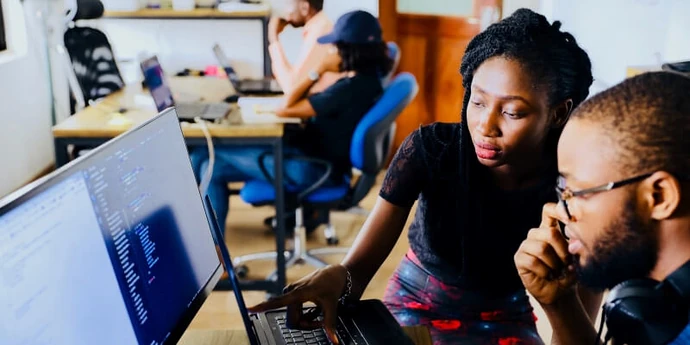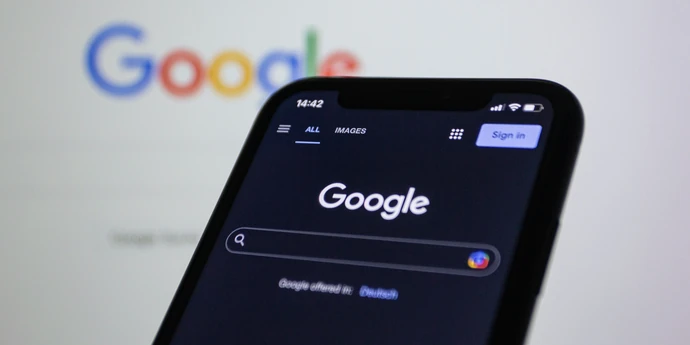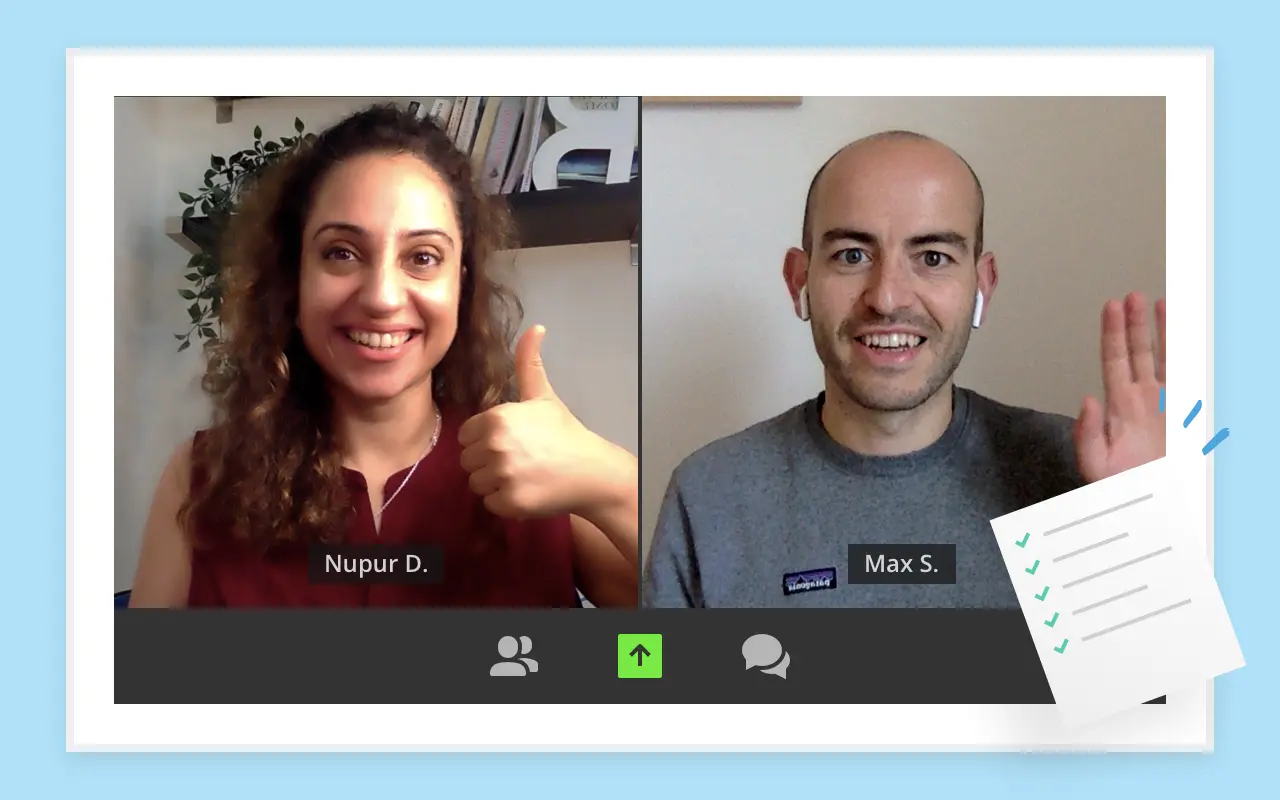Apple engineers solve some of the toughest technical problems out there, and they do it with style. That’s the bar for engineering managers (EM), too.
At Apple, EMs are expected to guide people and still contribute as hands-on engineers. It’s a demanding balance, and it’s part of what makes the interview process unique.
We’ve coached thousands of candidates through Apple and other FAANG interviews and work with 10+ former Apple interviewers on our platform, including some EMs. In this guide, we draw on that expertise to give you a roadmap for what to expect.
Click here to practice 1-on-1 with expert ex-Apple interviewers.
1. Apple Engineering Manager Role and Salary ↑
Before we dive into Apple’s interview process, let’s take a quick look at what life as an Apple engineering manager actually looks like.
1.1 What does an Apple engineering manager do?
Apple engineering managers work within a structure that looks different from most tech companies. They typically manage 3-5 full-time employees (FTEs) and dozens of contractors.
The philosophy is clear: if every contractor left tomorrow, the core team must still be able to ship the product. That creates a constant balancing act where you’re scaling through contractors while ensuring your FTEs remain the backbone of product development.
Because of this setup, Apple places strict guardrails around technical ownership. Only FTEs can approve designs, architecture, or code changes, which makes you, as the EM, accountable for maintaining technical excellence across a distributed workforce. Contractors handle the heavy-lift execution, while your full-timers focus on the strategic decisions that define Apple’s products.
But team structure is only part of the challenge. The work itself is deeply cross-functional, requiring relentless coordination across groups. As a former Apple EM explained, “Everything is insanely cross-functional, so only the best/strongest ideas make it through, and only after a TON of back-and-forth.”
There’s no standalone team. Hardware, firmware, OS, apps, sensors, and camera teams all report to different leaders. So driving progress means constant relationship management and negotiation across org lines.
On top of that, Apple’s management culture demands rigor. Senior leaders (Director and above) track details two layers below them, so every interaction requires painstaking preparation. EMs conduct internal reviews, manager and peer feedback, and even UX polishing sessions before materials are shown to leadership. The standard is high, and the visibility is intense.
Once you're in, the pace at Apple is relentless. Apple Engineering Leader Santosh describes the work environment as fast-paced, where you're constantly challenged to be at your best. You’ll deal with the company's notoriously tight deadlines and perfectionist culture, where "good enough" simply doesn't exist.
The company's culture of secrecy means engineering managers often work on confidential projects and don’t always see what other teams are doing. This requires you to make decisions on your own and keep things moving even when you don’t have the full picture.
All of this shapes how EMs spend their time. Roughly 80% of the role is non-technical — mentoring, unblocking, planning, and cross-functional alignment. The remaining 20% is technical, but it’s the part that makes or breaks your credibility: weighing in on architecture, challenging trade-offs, and approving critical code changes that could affect millions of users worldwide.
Despite the high expectations, Apple does provide, as Santosh puts it, flexibility and resources to help maintain work-life balance. But, the pressure to deliver remains constant. The reward, though, is that you get to work on products that define entire industries, with compensation packages that reflect the stakes involved.
1.2 Salary and compensation
Compensation for Apple EMs is among the most competitive in tech, which makes a lot of sense considering how high the stakes are and the level of work you’re handling.
For some perspective, an Apple engineering manager at the M1 (Manager 1) level can expect a total compensation package of around $460K per year. That’s already well above what many senior software engineers at other top tech companies earn. By the time you reach a director-level role (D1), total compensation can exceed $1.6M per year.
The median total compensation for Apple EMs in the U.S. is around $545K, and many earn even more. By comparison, the median compensation for Amazon EMs is $391.93K, while for Meta, it's $506.3K so Apple is up there as one of the top-paying companies in tech.
Apple’s compensation model has three main components, and it’s heavily weighted toward equity:
- Base Salary: This is your guaranteed paycheck. It increases predictably with experience and level.
- Restricted Stock Units (RSUs): Apple grants stock annually, vesting over four years. RSUs can fluctuate with Apple’s stock price, and they’re often the most negotiable part of your offer. At higher levels, RSUs make up the majority of total compensation.
- Annual Bonus: Typically, 15–25% of your base salary, paid yearly and tied to both individual and company performance. This can vary significantly depending on Apple’s financial results.
Here’s a breakdown by level (based on Levels.fyi):
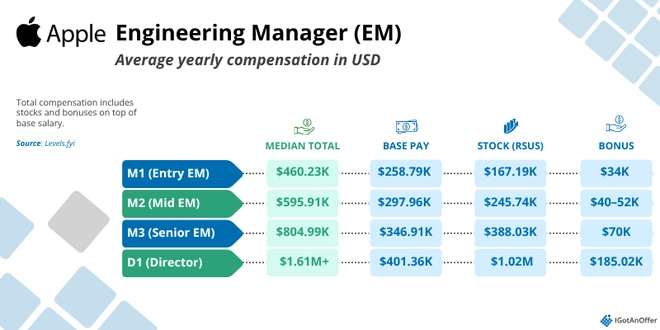
Perks and benefits are generous and designed to support both work and life. You get:
- Premium medical
- Dental and vision coverage
- Up to 18 weeks of paid parental leave
- 15% discount on Apple stock through the employee purchase plan
- Product discounts
- Wellness programs
- 401(k) retirement plans
- Flexible time off
Note: Compensation also adjusts for geographic location to account for cost-of-living differences.
If you need help negotiating your offer, check out our Apple job offer negotiation guide.
2. Apple Engineering Manager Interview Process and Timeline ↑
Now that you have a clear picture of what an Apple engineering manager actually does and how much they’re paid, let’s talk about how you actually get in.
2.1 What interviews to expect
Apple's engineering manager interview process typically takes 4-6 weeks from application to final decision and follows this structure:
Step 1: Resume screen (1-2 days)
Your application is initially reviewed by recruiters and hiring managers. Apple looks for a combination of strong technical background and leadership experience, with particular emphasis on consumer product experience.
To make sure your resume stands out, here’s a free engineering manager resume guide. It’ll help you get a gauge on what successful resumes look like so you can tweak yours accordingly.
And if you’re looking for expert feedback, you can also get input from our team of resume reviewers, who will cover what achievements to focus on (or ignore), how to fine-tune your bullet points, and more.
Step 2: Initial recruiter call (30 minutes)
This is usually 20–30 minutes, covering your background, experience, and why you want the role. This is also when they'll explain the interview process and next steps.
They'll ask about typically ask questions like:
- "Why Apple specifically?"
- "Any competing interview processes you have running?"
- Basic timeline expectations
Pro tip: Be upfront about your timeline. If you're interviewing elsewhere with faster processes, mention it. Apple can move faster when they need to, but only if you give them a reason.
Step 3: Hiring manager phone screen (30-45 minutes)
Once the recruiter is satisfied, you’ll speak with the hiring manager. This call dives deeper into your experience, your management style, and your technical abilities. Expect questions like:
- “Why do you want to do people management?”
- “Tell me about a time you disagreed with a cross-functional partner. How did you handle it?”
- “What’s the most technical part of your current role?”
Even here, Apple wants proof that you still understand the technical side of things. Some candidates were surprised that coding comes up even at this stage, but it’s a core expectation: Apple EMs must remain technically competent.
Also, the hiring manager will give you some context about the team, but don't expect much detail. Apple's culture of secrecy means hiring managers are deliberately vague about specific projects or technology stacks. They'll explain high-level responsibilities but avoid sharing confidential information about what the team is actually working on.
Hiring managers often seem rushed, but that’s just the reality of their schedules. Apple managers are genuinely busy, so conversations can feel abrupt or leave some details unexplored. It’s not a reflection on you.
Step 4: Technical phone screen (45-60 minutes)
There’s usually a small take-home assignment or a live coding session on CoderPad. The assignments are often Leetcode-style problems designed to see how you solve challenges efficiently and clearly with time constraints.
You’ll see stuff like arrays, graphs, dynamic programming, string manipulation, or even a tricky algorithm question. Apple just wants to know you can think logically, reason through edge cases, and debug on the fly.
Fair warning: some candidates report getting only 15 minutes of actual coding time due to scheduling issues or rushed interviewers. This is frustrating but not uncommon.
Step 5: Virtual onsite loop (4-7 interviews, full day)
Plan to block out a full day because Apple's onsite loops are comprehensive. Based on detailed candidate feedback, here's what you can expect:
- 2-3 behavioral/leadership interviews
- 1-2 coding interviews
- 1-2 system design interviews
- 1 cross-functional interview (working with product/design)
Step 6: Final interview with skip-level manager (30 minutes)
If you make it here, you're close. This is typically with a director or senior manager who'd be your skip-level. It's mostly focused on:
- Your management philosophy and how it aligns with Apple's culture
- Long-term career goals and growth trajectory
- How you think about building teams and developing people
This conversation tends to be more strategic and less tactical than previous rounds.
2.2 What exactly is Apple looking for?
Apple doesn’t have an official checklist for engineering manager candidates. But after coaching thousands of people through FAANG interviews and working with 90+ expert coaches (including former Apple EMs), we consistently see the same traits in candidates who succeed.
Our analysis of candidate outcomes, combined with insights from former Apple interviewers and the structure of Apple's interview process itself, shows that successful candidates consistently demonstrate:
Technical credibility: Apple EMs are expected to remain hands-on contributors who can weigh in on architecture decisions and code reviews.
Cross-functional collaboration skills: Multiple interview experiences mention questions about working with product, design, and other engineering teams. This aligns with Apple's highly cross-functional structure, where EMs constantly coordinate across org boundaries.
Leadership depth: The 2-3 behavioral rounds focus heavily on people management scenarios, conflict resolution, and project management. Former candidates report detailed follow-up questions about specific management decisions and outcomes.
Attention to quality and process: Interview questions often probe how you maintain standards, handle technical debt, and make trade-offs between shipping fast and getting things right.
Cultural alignment: The final interview often explores your management philosophy and how you think about building teams, suggesting Apple cares about leadership style fit beyond just skills.
These themes are consistent with what we know about Apple's engineering culture: technically rigorous, cross-functionally demanding, and quality-obsessed. But the specific weight given to each area likely varies by team and role level.
2.3 Timelines
Apple is more responsive than you might expect initially. First contact usually comes within a week of applying. But everything after that moves at Apple's pace, which is, as one of the interviewees put it, glacial.
Here's what candidates actually experienced:
- Fastest process: 34 days from application to decision
- Typical process: 5-7 weeks
- Slower processes: 8+ weeks (sometimes with multi-week gaps between stages)
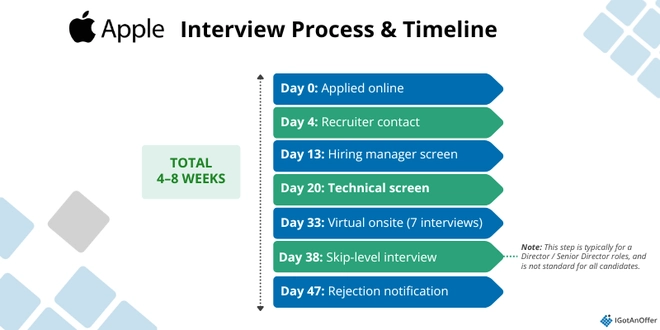
Why response takes so long:
- Scheduling nightmares: Apple engineers are busy. Really busy. Finding time for 6-7 interviews across multiple people can take weeks.
- Decision-making process: Apple doesn't make hiring decisions quickly. There are multiple layers of review and discussion.
- Team dependencies: If your potential team is in crunch mode or dealing with other priorities, your interview process gets deprioritized.
Tip: Ask your recruiter for typical timelines and when you should follow up. One polite email per week after expected decision dates will go a long way.
2.4 What happens behind the scenes (after interviews)
After your onsite interviews, here's what the final steps look like:
- Interviewers submit feedback (usually within 2-3 days)
- Hiring committee review: A panel reviews all feedback, along with your background
- Senior leadership approval
- Compensation committee review
- Final executive sign-off: A VP-level executive approves the hire and compensation
- Offer extended
3. Apple Engineering Manager Example Questions ↑
Like we mentioned earlier, Apple engineering manager interviews are designed to test both your technical skills and your ability to lead. In practice, that means you’ll see a mix of questions from these categories:
We’ve pulled together real Apple EM interview questions (sourced from Glassdoor) and organized them into categories. Some are lightly reworded for clarity, but the substance remains the same.
3.1 Leadership and behavioral questions
Apple places a lot of weight on leadership skills, just as much as technical ability. You'll usually go through two or three interviews focused entirely on behavioral and leadership questions during the on-site loop.
One of these behavioral interviews is typically framed as a "cross-functional" interview, where you'll discuss scenarios involving collaboration with product managers, designers, and other engineering teams.
Question types break down as:
- General behavioral questions: Things like why you want to work at Apple, how you handle failure, or your decision-making process with incomplete information.
- People management questions: How you handled performance issues, mentoring, difficult team dynamics, or hiring decisions.
- Project and program management questions: Your approach to planning, execution, prioritization, and what you do when projects inevitably hit roadblocks.
With that context in mind, here are some examples of the kinds of leadership questions Apple has asked in past interviews. These should give you a sense of both the themes and the level of depth you’ll want to be ready for.
Note: To give you a fuller picture of what to expect, we’ve also included examples from companies like Google, Meta, and others. Questions that don’t come directly from Apple are clearly marked with the company name in brackets.
Example questions from recent Apple EM interviews
General leadership
- Tell me about a time when you had to make a difficult decision with incomplete information. How did you handle it, and what was the outcome?
- What does success mean to you?
- What areas do you think you need to develop further as a leader? (Meta)
- Why do you want to take this role at Apple specifically?
- Describe a time when you had to change your leadership approach for different team members.
People management
- How do you manage people? Walk me through your management philosophy.
- Why do you want to pursue a career in people management? What was your most rewarding experience in people management?
- How have you dealt with a problem employee in the past?
- How do you handle people who are not team players? (Google)
- How would you deal with unhealthy competition within your team? (Google)
- How do you deal with low/high performers? (Google)
Project management
- If you have 2 clients requesting very different features for the same product, how would you prioritize them?
- What's one time you didn't have the technical knowledge for a solution and had to bridge the gap?
- Tell me about a project that was behind schedule. What specific steps did you take to get it back on track? (Amazon)
- Describe an instance where you had to make an important decision without approval from your boss. (Amazon)
You can find more questions to practice with by reviewing our guide to people management interviews and our guide to behavioral interviews for engineers.
3.2 System design questions
System design interviews at Apple are less about solving a textbook problem and more about showing how you think. Interviewers want to see how you balance high-level architecture with detailed technical decisions, especially in the context of Apple’s scale and consumer-facing products.
A few things to keep in mind:
- No one expects a flawless blueprint. What matters is how you structure your approach, the questions you ask, and the trade-offs you highlight.
- This round is also often a key input in determining what level you’ll be hired at. Strong design instincts can push you up, while hand-wavy thinking can hold you back.
Talking to ex-Meta engineering manager, Pranav, he explained to us that FAANG companies rarely frame these as neat, self-contained questions. And that applies at Apple, too. You may not get “Design a URL shortener” straight out, but you’ll still touch on those concepts as part of broader conversations around scalability, reliability, and user experience.
Because there’s so much ground to cover, the best way to prepare is systematically. You’ll want to get comfortable across two main dimensions:
- High-level system architecture (how to break down large, complex systems into workable pieces)
- Low-level design and optimization (how to dive deeper into the details, data flows, and performance tuning that make the system viable in practice)
With that framing, here are some of the categories and example questions you can expect to see.
Example system design questions from Apple EM interviews
High-level system design
- Design a method to find the first available meeting slot for multiple parties.
- Design a distributed caching system for App Store metadata.
- Design a voice assistant to provide weather services. (Google)
- Design a backend processing layer for logging data from a web page. (Google)
- Design a load balancer from scratch. (Google)
- Design a feature for Microsoft Teams targeting university students in Japan. (Microsoft)
Low-level system design
- Can you walk me through the internals of Spring and explain the criteria you’d use for server selection?
- Write code to implement a basic algorithm, like binary search or a sorting algorithm.
- How did you evaluate the design of your system? (Uber)
- How did you test performance and scalability? (Uber)
- Explain the differences between relational and NoSQL databases and when to use each. (Uber)
For more questions with sample answer outlines, take a look at our list of system design interview questions.
3.3 Coding questions
Apple EM coding questions aren’t exactly public, so most of what we know comes from Amazon, Google, Meta, and other FAANG interviews. Thankfully, we’ve also leaned on experts (former EMs, recruiters, and engineers) who’ve been through the process and shared what actually happens behind the scenes.
In any case, Apple’s interviewers also draw, in some capacity, from the same playbook you’ll see at these FAANG companies. So, we’ve included some typical coding questions across these companies.
Example coding questions from Apple EM interviews
1. Trees/Graphs
- Given a binary tree, find the maximum path sum. The path may start and end at any node in the tree. (Google EM question)
- Given two words (beginWord and endWord) and a dictionary's word list, find the length of the shortest transformation sequence from beginWord to endWord. (Google EM question)
- Design and implement a data structure for Least Recently Used (LRU) cache. (Google EM question)
2. Arrays/Strings
- Given a sorted dictionary (array of words) of an alien language, find the order of characters in the language. (Amazon EM question)
- Given an array arr[] of size n, its prefix sum array is another array prefixSum[] of the same size, such that the value of prefixSum[i] is arr[0] + arr[1] + arr[2] … arr[i]. (Amazon EM question)
- Given an array of integers, find the next biggest number. (Amazon EM question)
- Given an input of two arrays that represent computers' power output (powerOutputs) and boosted output (boostedOutputs) and a maximum allowed power (powerMax), return the maximum amount of adjacent computers that are less than or equal to powerMax given the formula totalPowerOutput = powerOutputs[i] + powerOutputs[i + 1...] + (boostedOutputs[i] + boostedOutputs[i + 1...] * numOfAdjacentComputers). (Amazon EM question)
3. Dynamic Programming
- Given two strings text1 and text2, return the length of their longest common subsequence. If there is no common subsequence, return 0. (Google EM question)
- Find the minimum number of coins needed for change. (Google EM question)
- Non-overlapping intervals (Google EM question)
- Given a matrix and a target, return the number of non-empty submatrices that sum to target. (Google EM question)
4. Recursion/Backtracking
- Calculate the sum in a tree (Meta EM question)
- The N-Queens problem (Meta EM question)
Pro tip: Preparation makes all the difference. We’ve guided thousands of candidates through coding interviews at top tech companies, so we have a pretty solid sense of what works and what doesn’t. To learn more, read our guide on how to get better at coding interviews, with tips from FAANG interviewers.
4. Interview Tips ↑
Because we coach thousands of FAANG candidates every year, we see what works (and what doesn’t) in Apple’s EM process.
What follows is organized around the three phases of your interview journey: before, during, and after. You’ll also get candid takes on Apple’s quirks and practical ways to handle them instead of just crossing your fingers.
4.1 Before the interview: preparation strategy
Create your "story box"
The biggest game-changer for behavioral interviews is having a story bank ready. One candidate described their approach:
"I aggregated every EM example question I could find on the web and spent time trying to recall specific examples I could point to for all of them, along with ways to not reuse the same situation for other questions as much as possible. This prep work made the interviews a breeze."
We have a full compilation of the most-asked software engineer behavioral interview questions (with answers) here you can start with. You’ll find structured examples, proven frameworks, and sample answers that show you exactly how to frame your own experience in a way that resonates with interviewers.
Practice makes perfect (but practice smart)
One of the most effective ways to ace behavioral interviews is to thoroughly prepare your stories. What that means is collecting a solid set of experiences that highlight your leadership, problem-solving, and people management, then breaking each one down into a clear, concise narrative.
You write these stories on note cards, rehearse them until you can deliver each in under a minute. Best to even practice in front of someone who can give you honest feedback.
When structuring your stories, frameworks help you cover all the important points without rambling or missing key details. You'll hear a lot about the Situation, Task, Action, Result (STAR) framework out there. It's popular because it works. But honestly, it can be a bit lacking. It's hard to tell between steps two and three, or task and action.
That's why one of the frameworks we always recommend is IGotAnOffer’s method: Situation-Problem-Solution-Impact-Lessons (SPSIL). It corrects some of the pitfalls we've observed when using the STAR method.
You can learn more about SPSIL here.
Just remember that early attempts will most likely come out robotic. That's why part of the prep is making the storytelling feel natural and conversational, without getting so locked into frameworks that you miss the actual question being asked.
Set realistic timeline expectations
Ask your recruiter for typical timelines and when you should follow up. More importantly, don't pause other opportunities while waiting for Apple. The process can stretch 6-8 weeks, and you don't want to lose other options due to Apple's slow pace.
4.2 During the interview: execution strategy
Show your growth mindset
Apple values continuous learning and adaptation. Throughout your interviews, demonstrate how you've evolved as a leader, learned from failures, and adapted your management style based on team needs.
"Do the stories and experiences that you're giving show that you're always looking to grow and learn, rather than having a fixed mindset? That's an important signal the interviewer is looking out for." — Mark, EM coach
Ask clarifying questions first
Uber EM, Tatiana Maluf, explained that: "When a problem is presented to you, don't start drawing the solution immediately. First, ask questions to clarify all the details you need."
This is especially important for system design problems where assumptions can derail your entire solution.
Share your thought process clearly
Apple interviewers want to understand how you think, not just what you know. Walk through your reasoning step by step, especially during technical portions. This is particularly important since Apple EMs are expected to mentor engineers and explain technical concepts.
Focus on your strengths
Here's an important reality check from a successful candidate: "Don't stress the coding interview. I failed mine (partial solution) and still got hired as an M1. I did well on the behavioral and system design interviews, and that's what really mattered in the end."
Apple evaluates you holistically. If you're stronger in leadership and system thinking than algorithms, lean into those strengths while still showing some coding competency.
Treat it like a conversation
Remember that interviews are two-way discovery processes. While they're assessing fit, you're also evaluating whether Apple aligns with your career goals. Ask thoughtful questions about team dynamics, technical challenges, and growth opportunities.
4.3 After the interview
Follow up strategically
When your interview finishes, you'll be given guidance about what happens next. If you aren't, Apple's official interview guidance says to follow up with your recruiter.
Most communication during Apple's interview process flows through your assigned recruiter. If they've provided you with direct contact information, a brief follow-up email after your interviews can help reinforce your interest. However, don't worry if you don't have direct contact. Apple's process typically includes regular updates at predetermined intervals.
If you haven't heard back by the timeline mentioned during your last interview, and you have the recruiter's contact information, one polite follow-up email per week is appropriate.
The goal is to show you’re organized, engaged, and can handle the rhythm of a high-stakes process without losing your calm.
Keep other processes moving
Don't put your job search on hold for Apple. The company's slow decision-making process means you could miss other opportunities while waiting.
Prepare for silence
Unfortunately, ghosting after final rounds is not uncommon at Apple. If you don't hear back within 2-3 weeks of your last interview:
- Send one final follow-up email expressing continued interest
- Assume it's likely a silent rejection and focus energy elsewhere
- Don't take it personally. This is a process issue, not a reflection on your candidacy
“Apple recruiters are notoriously flakey, and my experience left a lot to be desired. The process was delayed multiple times, and timelines were miscommunicated. Many times I wondered if I would be ghosted.” — Zack, Apple site reliability engineer
Learn from the experience
Whether you get the offer or not, Apple's rigorous process provides valuable feedback on your technical and leadership capabilities. Use the experience to:
- Identify areas for improvement in future interviews
- Refine your story bank based on the questions you struggled with
- Understand your own preferences about company culture and communication styles
If you get rejected
Apple's hiring bar is notoriously high, and rejection doesn't mean you're not qualified. Just that this particular role wasn't the right fit. Many successful Apple employees were rejected on their first attempt and hired later when they had more experience or interviewed for a different team.
Consider applying again after 6-12 months if you've gained additional experience or if different roles open up that better match your background.
5. How to Prepare ↑
Now that you know what questions to expect, let's focus on preparation.
Below, you’ll find links to free resources and introductory steps to help you prepare for your Apple EM interviews.
5.1 Deep dive into the product/organization
Most candidates skip this step. But before pouring tens of hours into Apple interview prep, it’s worth pausing to ask if Apple is the right fit for you.
Apple’s brand and influence make it easy to assume you should apply. But prestige alone won’t make your day-to-day work fulfilling. What will matter most are the problems you’ll be solving and the people you’ll be solving them with.
If you know current or former Apple engineers, take the time to ask them about the culture and how teams actually operate. Their perspective will give you a clearer picture than headlines ever could. You can also explore resources like:
- Apple Core Values
- Apple Investor Relations
- Apple Strategy Teardown (from CB Insights)
- Apple’s Company Culture: An Organizational Analysis (by Panmore Institute)
- Apple’s Marketing Mix: 4P Analysis (by Panmore Institute)
- Apple Mission and Vision Statement Analysis
- How Apple is Organized for Innovation (by Harvard Business Review)
- Apple's Culture Rejects the Conventional Wisdom of Product Design (by Inc)
Once you’re comfortable with the culture and team operations, the next step is practice.
5.2 Practice by yourself
Finally, one of the best ways to improve your communication for leadership and system design questions is to interview yourself out loud. It might feel a little strange at first, but playing both the candidate and the interviewer can significantly improve the way you communicate your answers.
As we've outlined above, you'll have to prepare for several different categories of questions ahead of your Apple engineering manager interviews.
But the good news is that there is a lot of overlap between the initial interview question categories and the onsite interviews.
These deep-dive articles can help you prepare for each question category. Here's a good list, plus a couple extras we think could be useful.
- Leadership questions
- People management: People management questions in tech interviews
- Project/Program management: Program/project management questions in tech interviews
- Collaboration and Partnerships: Dealing with conflict, dealing with stakeholders
- General: Grokking the engineering management leadership interview, Meta behavioral interview questions
- Technical design & architecture: System design fundamentals (series of 9 articles)
- Retrospectives: Guide to technical retrospectives by Tony Wu (ex-FB)
- Coding: Coding interview prep
Interviewing for an EM role at another company? You may also want to check out our other company-specific EM interview guides:
- Microsoft engineering manager interview guide
- Google engineering manager interview guide
- Netflix engineering manager interview guide
- Meta engineering manager interview guide
- Uber engineering manager interview guide
- DoorDash Engineering manager interview guide
Of course, practicing alone can only take you so far. It doesn’t fully prepare you for the pressure of thinking on your feet, handling unexpected follow-up questions, or getting real-time feedback.
That’s why many candidates choose to practice with friends or peers. This helps recreate the interview environment and gives you a chance to refine your answers based on constructive feedback.
5.3 Practice with peers
You can practice alone, but you’ll find that it has limits. You don’t get the pressure of thinking on your feet, the curveball follow-up questions, or the feedback that helps you improve. That’s why many candidates turn to friends or peers to rehearse.
It’s free, but be warned, you may come up against the following problems:
It’s hard to know if the feedback you get is accurate. They’re unlikely to have insider knowledge of interviews at your target company. On peer platforms, people often waste your time by not showing up.
For those reasons, many candidates skip peer mock interviews and go straight to mock interviews with an expert.
5.4 Practice with experienced interviewers
In our experience, practicing real interviews with experts who can give you company-specific feedback makes a huge difference.
Find an Apple engineering manager interview coach so you can:
- Test yourself under real interview conditions
- Get accurate feedback from a real expert
- Build your confidence
- Get company-specific insights
- Learn how to tell the right stories, better
- Save time by focusing your preparation
Landing a job at a big tech company often results in a $50,000 per year or more increase in total compensation. In our experience, three or four coaching sessions worth ~$500 make a significant difference in your ability to land the job. That’s an ROI of 100x!
Click here to book engineering manager mock interviews with experienced interviewers.









